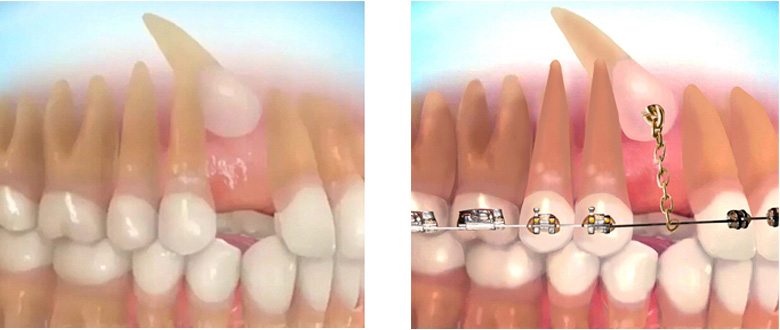
Revelation of trapped teeth

Uncovering Impacted Teeth: When Extraction is Not the Solution
The appearance of impacted teeth refers to the delayed eruption of one or more teeth that remain “trapped” beneath the gums. This can occur due to a lack of space or other anatomical or pathological factors. Typically, when dealing with impacted or partially impacted wisdom teeth (the most common case), treatment involves extraction, as these teeth provide no functional benefit and often cause issues in the dentition.
However, when impacted teeth involve teeth with a significant functional role in the mouth—such as canines—extraction is not always the best solution. Canines are essential for proper occlusion and smooth chewing, and they also affect the aesthetics of the smile. In such cases, the preferred solution is surgical exposure of the impacted tooth, allowing it to erupt properly and be integrated into the natural dentition.

Uncovering Impacted Teeth: When Extraction is Not the Solution
The appearance of impacted teeth refers to the delayed eruption of one or more teeth that remain “trapped” beneath the gums. This can occur due to a lack of space or other anatomical or pathological factors. Typically, when dealing with impacted or partially impacted wisdom teeth (the most common case), treatment involves extraction, as these teeth provide no functional benefit and often cause issues in the dentition.
However, when impacted teeth involve teeth with a significant functional role in the mouth—such as canines—extraction is not always the best solution. Canines are essential for proper occlusion and smooth chewing, and they also affect the aesthetics of the smile. In such cases, the preferred solution is surgical exposure of the impacted tooth, allowing it to erupt properly and be integrated into the natural dentition.

Uncovering Impacted Teeth: When Extraction is Not the Solution
The appearance of impacted teeth refers to the delayed eruption of one or more teeth that remain “trapped” beneath the gums. This can occur due to a lack of space or other anatomical or pathological factors. Typically, when dealing with impacted or partially impacted wisdom teeth (the most common case), treatment involves extraction, as these teeth provide no functional benefit and often cause issues in the dentition.
However, when impacted teeth involve teeth with a significant functional role in the mouth—such as canines—extraction is not always the best solution. Canines are essential for proper occlusion and smooth chewing, and they also affect the aesthetics of the smile. In such cases, the preferred solution is surgical exposure of the impacted tooth, allowing it to erupt properly and be integrated into the natural dentition.

How Is the Exposure of Impacted Teeth Performed?
The exposure of an impacted tooth is a surgical procedure aimed at helping a tooth that has not fully erupted into the mouth to emerge properly.
This procedure is typically performed under local anesthesia and involves the following steps:
Tooth localization: Imaging (such as X-rays or CBCT scans) is used to accurately determine the position of the impacted tooth.
Incision in the mucosa: A small incision is made in the gum tissue to expose the tooth.
Bone removal: If the tooth is covered by bone, a portion of the bone is removed to access the tooth.
Placement of an orthodontic attachment: In many cases, a small orthodontic bracket is bonded to the tooth and connected to a wire or chain. This allows the tooth to be gradually guided into its correct position within the dental arch.

How Is the Exposure of Impacted Teeth Performed?
The exposure of an impacted tooth is a surgical procedure aimed at helping a tooth that has not fully erupted into the mouth to emerge properly.
This procedure is typically performed under local anesthesia and involves the following steps:
Tooth localization: Imaging (such as X-rays or CBCT scans) is used to accurately determine the position of the impacted tooth.
Incision in the mucosa: A small incision is made in the gum tissue to expose the tooth.
Bone removal: If the tooth is covered by bone, a portion of the bone is removed to access the tooth.
Placement of an orthodontic attachment: In many cases, a small orthodontic bracket is bonded to the tooth and connected to a wire or chain. This allows the tooth to be gradually guided into its correct position within the dental arch.

How Is the Exposure of Impacted Teeth Performed?
The exposure of an impacted tooth is a surgical procedure aimed at helping a tooth that has not fully erupted into the mouth to emerge properly.
This procedure is typically performed under local anesthesia and involves the following steps:
Tooth localization: Imaging (such as X-rays or CBCT scans) is used to accurately determine the position of the impacted tooth.
Incision in the mucosa: A small incision is made in the gum tissue to expose the tooth.
Bone removal: If the tooth is covered by bone, a portion of the bone is removed to access the tooth.
Placement of an orthodontic attachment: In many cases, a small orthodontic bracket is bonded to the tooth and connected to a wire or chain. This allows the tooth to be gradually guided into its correct position within the dental arch.



The Importance of Prevention and Early Intervention
The exposure of impacted teeth is most effective when the patient is monitored from an early age, during the period of natural tooth eruption.
Early diagnosis allows for a combined approach of prevention and treatment, reducing the risk of future complications and avoiding more complex procedures.
The procedure can also be performed at a later age, provided the tooth is still capable of erupting.
Alongside surgical exposure, orthodontic appliances help guide the tooth into its proper position, ensuring a better aesthetic and functional outcome.

The Importance of Prevention and Early
Intervention
The exposure of impacted teeth is most effective when the patient is monitored from an early age, during the period of natural tooth eruption.
Early diagnosis allows for a combined approach of prevention and treatment, reducing the risk of future complications and avoiding more complex procedures.
The procedure can also be performed at a later age, provided the tooth is still capable of erupting.
Alongside surgical exposure, orthodontic appliances help guide the tooth into its proper position, ensuring a better aesthetic and functional outcome.

The Importance of Prevention and Early Intervention
The exposure of impacted teeth is most effective when the patient is monitored from an early age, during the period of natural tooth eruption.
Early diagnosis allows for a combined approach of prevention and treatment, reducing the risk of future complications and avoiding more complex procedures.
The procedure can also be performed at a later age, provided the tooth is still capable of erupting.
Alongside surgical exposure, orthodontic appliances help guide the tooth into its proper position, ensuring a better aesthetic and functional outcome.

Benefits of Surgical Uncovering of Impacted Teeth
Restoration of proper dental alignment and correct occlusal function.
Improvement of smile aesthetics, which can boost self-esteem and social interaction.
Prevention of complications such as cysts or damage to the roots of adjacent teeth.
Preservation of natural teeth and avoidance of more invasive solutions (e.g., implants).

Benefits of Surgical Uncovering of
Impacted Teeth
Restoration of proper dental alignment and correct occlusal function.
Improvement of smile aesthetics, which can boost self-esteem and social interaction.
Prevention of complications such as cysts or damage to the roots of adjacent teeth.
Preservation of natural teeth and avoidance of more invasive solutions (e.g., implants).

Benefits of Surgical Uncovering of Impacted Teeth
Restoration of proper dental alignment and correct occlusal function.
Improvement of smile aesthetics, which can boost self-esteem and social interaction.
Prevention of complications such as cysts or damage to the roots of adjacent teeth.
Preservation of natural teeth and avoidance of more invasive solutions (e.g., implants).



